英文演讲之文化差异Derek Sivers- Weird, or just different
- 格式:doc
- 大小:28.00 KB
- 文档页数:2
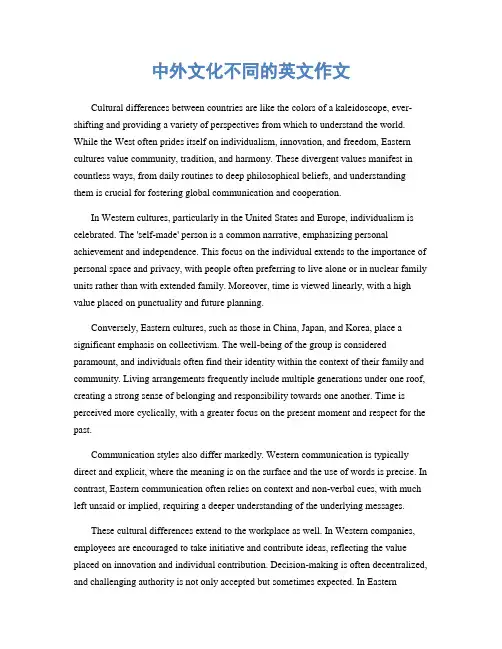
中外文化不同的英文作文Cultural differences between countries are like the colors of a kaleidoscope, ever-shifting and providing a variety of perspectives from which to understand the world. While the West often prides itself on individualism, innovation, and freedom, Eastern cultures value community, tradition, and harmony. These divergent values manifest in countless ways, from daily routines to deep philosophical beliefs, and understanding them is crucial for fostering global communication and cooperation.In Western cultures, particularly in the United States and Europe, individualism is celebrated. The 'self-made' person is a common narrative, emphasizing personal achievement and independence. This focus on the individual extends to the importance of personal space and privacy, with people often preferring to live alone or in nuclear family units rather than with extended family. Moreover, time is viewed linearly, with a high value placed on punctuality and future planning.Conversely, Eastern cultures, such as those in China, Japan, and Korea, place a significant emphasis on collectivism. The well-being of the group is considered paramount, and individuals often find their identity within the context of their family and community. Living arrangements frequently include multiple generations under one roof, creating a strong sense of belonging and responsibility towards one another. Time is perceived more cyclically, with a greater focus on the present moment and respect for the past.Communication styles also differ markedly. Western communication is typically direct and explicit, where the meaning is on the surface and the use of words is precise. In contrast, Eastern communication often relies on context and non-verbal cues, with much left unsaid or implied, requiring a deeper understanding of the underlying messages.These cultural differences extend to the workplace as well. In Western companies, employees are encouraged to take initiative and contribute ideas, reflecting the value placed on innovation and individual contribution. Decision-making is often decentralized, and challenging authority is not only accepted but sometimes expected. In Easternbusinesses, however, there is a greater respect for hierarchy and age, with decisions frequently made by senior members, reflecting a societal reverence for experience and age.Education systems reflect these cultural values too. Western education encourages critical thinking, debate, and exploration, with students often learning through discussion and inquiry. In Eastern education, there is a stronger emphasis on rote memorization, respect for teachers, and a focus on exams, which are seen as crucial determinants of future success.Food, an integral part of culture, also showcases these differences. Western cuisine often features a main course centered around a protein, accompanied by sides. Meals are typically structured with clear courses and a focus on individual servings. Eastern cuisine, on the other hand, is characterized by shared dishes, with a variety of flavors and textures designed to be eaten together, reflecting the communal aspect of the culture.Understanding and appreciating these cultural differences is not about determining which is better or worse; it's about recognizing the beauty and complexity of the world's diverse cultures. As globalization brings us closer together, the ability to navigate and respect these differences becomes increasingly important. It allows for more effective communication, fosters international relationships, and enriches our global society.In conclusion, the tapestry of human culture is woven with threads of both similarity and difference. By exploring and understanding the nuances of these cultural distinctions, we can build bridges of understanding that connect us all, making the world a more cohesive and harmonious place. Whether it's through the lens of individualism or collectivism, communication or cuisine, each culture offers unique insights and contributions to the global community. The key is to approach these differences with an open mind and a willingness to learn, for it is through this understanding that we can truly appreciate the richness of our world's cultural mosaic. 。
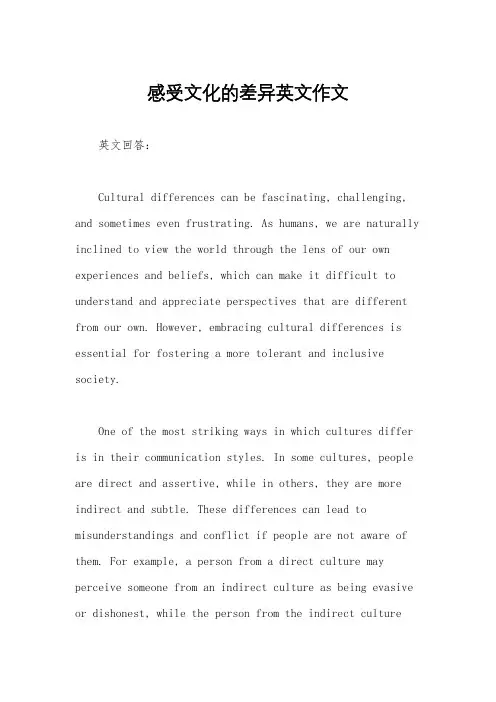
感受文化的差异英文作文英文回答:Cultural differences can be fascinating, challenging, and sometimes even frustrating. As humans, we are naturally inclined to view the world through the lens of our own experiences and beliefs, which can make it difficult to understand and appreciate perspectives that are different from our own. However, embracing cultural differences is essential for fostering a more tolerant and inclusive society.One of the most striking ways in which cultures differ is in their communication styles. In some cultures, people are direct and assertive, while in others, they are more indirect and subtle. These differences can lead to misunderstandings and conflict if people are not aware of them. For example, a person from a direct culture may perceive someone from an indirect culture as being evasive or dishonest, while the person from the indirect culturemay view the person from the direct culture as being rudeor aggressive.Another area where cultural differences can be evidentis in the way that people perceive time. In some cultures, people are very time-oriented and punctual, while in others, they are more relaxed and flexible with their schedules. These differences can be frustrating when people from different cultures try to work together. For example, a person from a time-oriented culture may become impatientwith a person from a more relaxed culture who is not as punctual.Cultural differences can also be seen in the way that people dress, eat, and socialize. For example, in some cultures, it is considered important to dress modestly,while in others, people are more comfortable with revealing clothing. Similarly, some cultures have very formal dining customs, while others are more casual. These differencescan be challenging to navigate when people from different cultures interact with each other.Despite the challenges, embracing cultural differences is essential for creating a more harmonious and understanding world. By learning about and respecting different cultures, we can break down barriers and build bridges between people.中文回答:文化的差异是一件迷人、具有挑战性、有时甚至令人沮丧的事情。
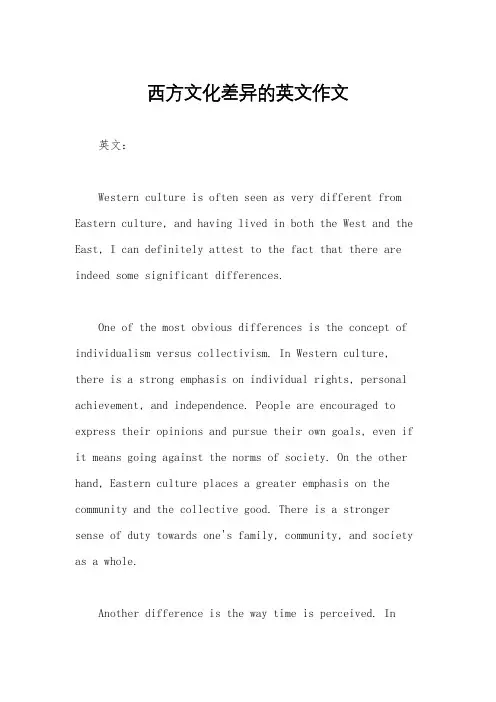
西方文化差异的英文作文英文:Western culture is often seen as very different from Eastern culture, and having lived in both the West and the East, I can definitely attest to the fact that there are indeed some significant differences.One of the most obvious differences is the concept of individualism versus collectivism. In Western culture, there is a strong emphasis on individual rights, personal achievement, and independence. People are encouraged to express their opinions and pursue their own goals, even if it means going against the norms of society. On the other hand, Eastern culture places a greater emphasis on the community and the collective good. There is a stronger sense of duty towards one's family, community, and society as a whole.Another difference is the way time is perceived. InWestern culture, time is often seen as a commodity that needs to be managed and used efficiently. Punctuality is highly valued, and people are expected to adhere to schedules and deadlines. In contrast, Eastern culture tends to have a more relaxed attitude towards time. Punctualityis not always a top priority, and people are more likely to prioritize relationships and experiences over strict adherence to time.Furthermore, the communication style in Western culture tends to be more direct and explicit. People are encouraged to speak their minds and be assertive in expressing their opinions. In Eastern culture, communication is often more indirect and implicit. People are more likely to use nonverbal cues and context to convey their messages, and there is a greater emphasis on maintaining harmony and avoiding conflict.In terms of social etiquette, there are also notable differences. For example, in Western culture, it is common to greet someone with a firm handshake and maintain eye contact during conversation as a sign of confidence andsincerity. In Eastern culture, greetings may involve a bow or a nod, and prolonged eye contact can be seen as intrusive or disrespectful.Overall, these cultural differences can lead to misunderstandings and miscommunications, especially for those who are not familiar with both Western and Eastern cultures. However, I believe that by being open-minded and willing to learn about and appreciate different cultural perspectives, we can bridge the gap and foster greater understanding and harmony between the East and the West.中文:西方文化和东方文化往往被认为有很大的不同,我在西方和东方都生活过,可以肯定地说确实存在一些显著的差异。
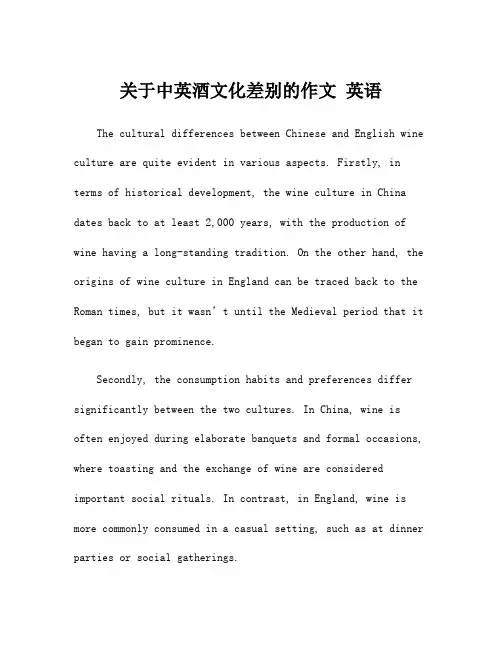
关于中英酒文化差别的作文英语The cultural differences between Chinese and English wine culture are quite evident in various aspects. Firstly, in terms of historical development, the wine culture in China dates back to at least 2,000 years, with the production of wine having a long-standing tradition. On the other hand, the origins of wine culture in England can be traced back to the Roman times, but it wasn’t until the Medieval period that it began to gain prominence.Secondly, the consumption habits and preferences differ significantly between the two cultures. In China, wine is often enjoyed during elaborate banquets and formal occasions, where toasting and the exchange of wine are considered important social rituals. In contrast, in England, wine is more commonly consumed in a casual setting, such as at dinner parties or social gatherings.Furthermore, there are considerable differences in the types of wine preferred in each culture. Chinese consumerstend to favor red wine, particularly those with a higher alcohol content. Meanwhile, English consumers have a preference for a wider variety of wines, including red, white, rosé, and sparkling wines.Additionally, the etiquette and customs associated with wine consumption also vary between the two cultures. For example, in China, it is customary to pour wine for others before serving oneself, and the order in which people are served is based on their seniority or social status. On the other hand, in England, there are fewer formalities surrounding wine consumption, with a focus on simply enjoying the drink in a relaxed manner.Moreover, the production and marketing of wine differ between the two cultures. Chinese wine production is characterized by the use of traditional methods and thecultivation of native grape varieties. In contrast, English wine production has seen a resurgence in recent years, with an emphasis on modern techniques and the cultivation of grape varieties such as Chardonnay, Pinot Noir, and Bacchus.In conclusion, the differences between Chinese and English wine culture are apparent in various aspects, including historical development, consumption habits, preferences, etiquette, and production. Understanding and appreciating these cultural distinctions can provide insight into the unique traditions and values associated with wine in each respective culture.。

文化差异的英语作文Title: Understanding Cultural Differences。
Culture is a multifaceted aspect of human society, encompassing traditions, beliefs, values, and behaviorsthat shape how individuals perceive and interact with the world around them. As our world becomes increasingly interconnected, understanding cultural differences has become more crucial than ever before. In this essay, wewill delve into the significance of cultural differences and explore strategies for fostering cross-cultural understanding.First and foremost, it's essential to recognize that cultural differences exist on various levels, including but not limited to language, customs, social norms, and communication styles. These differences can manifest in subtle nuances or more profound disparities, influencing interpersonal relationships, business practices, and societal structures. For instance, while directcommunication may be valued in some cultures for itsclarity and efficiency, others may prioritize indirect communication to preserve harmony and avoid confrontation.One of the most significant challenges posed bycultural differences is the potential for misunderstanding and misinterpretation. When individuals from different cultural backgrounds interact, there is a risk of misconstruing gestures, expressions, or words due to cultural context. These misunderstandings can lead to conflict, confusion, or even offense if not addressed with sensitivity and open-mindedness. Therefore, cultivating cultural competence is essential for navigating diverse social landscapes and fostering meaningful connections across cultures.So, how can we bridge the gap between cultures and promote mutual understanding? One approach is through education and exposure to different cultural perspectives. By learning about the history, traditions, and values of other cultures, individuals can gain insights into the underlying motivations and behaviors of people from diversebackgrounds. This knowledge serves as a foundation for empathy and respect, allowing individuals to navigate cultural differences with curiosity rather than judgment.Moreover, effective communication is key to navigating cultural differences successfully. This entails not only linguistic proficiency but also an awareness of nonverbal cues, such as body language, facial expressions, and tone of voice. In cross-cultural interactions, individuals should strive to listen actively, clarify assumptions, and express themselves clearly and respectfully. Additionally, being open to feedback and willing to adapt one's communication style to accommodate cultural differences can facilitate smoother intercultural communication.Another strategy for promoting cross-cultural understanding is through intercultural dialogue and collaboration. By bringing together individuals from diverse backgrounds to work towards common goals, organizations and communities can leverage the richness of cultural diversity to foster creativity, innovation, and mutual learning. Through collaborative endeavors,individuals can gain firsthand experience in navigating cultural differences, building trust, and forgingmeaningful relationships based on shared values and objectives.Furthermore, it's essential to recognize and challenge cultural stereotypes and biases that can hinderintercultural understanding. Stereotypes oversimplify and generalize complex cultural identities, perpetuating misconceptions and prejudice. By challenging stereotypesand embracing cultural diversity in all its complexity, individuals can cultivate a more inclusive and equitable society where everyone's unique perspectives are valued and respected.In conclusion, cultural differences are an inherent aspect of human society, shaping our identities, interactions, and worldview. While these differences may pose challenges, they also present opportunities for growth, learning, and collaboration. By fostering cultural competence, embracing diversity, and engaging in opendialogue, we can bridge the gap between cultures and build a more interconnected and harmonious world.。
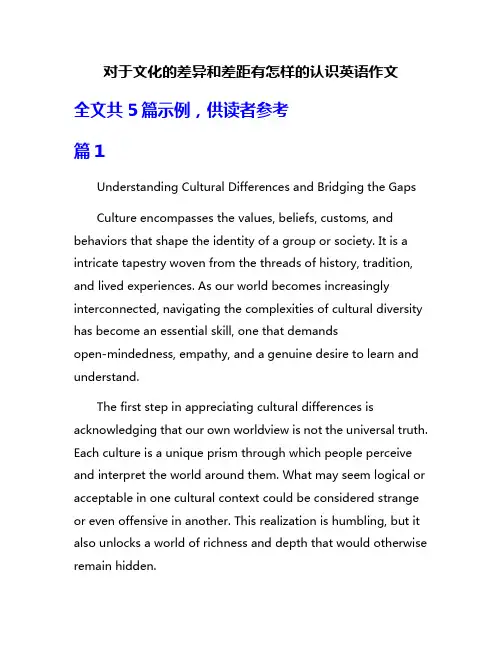
对于文化的差异和差距有怎样的认识英语作文全文共5篇示例,供读者参考篇1Understanding Cultural Differences and Bridging the GapsCulture encompasses the values, beliefs, customs, and behaviors that shape the identity of a group or society. It is a intricate tapestry woven from the threads of history, tradition, and lived experiences. As our world becomes increasingly interconnected, navigating the complexities of cultural diversity has become an essential skill, one that demandsopen-mindedness, empathy, and a genuine desire to learn and understand.The first step in appreciating cultural differences is acknowledging that our own worldview is not the universal truth. Each culture is a unique prism through which people perceive and interpret the world around them. What may seem logical or acceptable in one cultural context could be considered strange or even offensive in another. This realization is humbling, but it also unlocks a world of richness and depth that would otherwise remain hidden.Take, for instance, the concept of time. In some cultures, punctuality is paramount, with every minute meticulously accounted for. In others, time is viewed as a fluid concept, with meetings and gatherings starting and ending more loosely. Neither perspective is inherently right or wrong; they simply reflect different cultural priorities and values. Understanding these nuances can prevent misunderstandings and foster greater mutual respect.Language, too, is a window into cultural diversity. Words and phrases that seem innocuous in one tongue may carry unintended connotations or offense in another. The very structure of a language can shape the way its speakers perceive and express ideas. Learning another language, therefore, is not merely an exercise in vocabulary and grammar; it is an opportunity to glimpse the world through a different cultural lens.Perhaps one of the most visible manifestations of cultural diversity lies in the realm of art, music, and literature. These expressions of human creativity are deeply rooted in the cultural soil from which they sprung. Appreciating the symbolism, rhythms, and narratives of diverse artistic traditions can open ourminds to new perspectives and broaden our understanding of the human experience.However, bridging cultural gaps is not merely an intellectual exercise; it requires emotional intelligence and a genuine desire to connect with others. It involves suspending judgment, actively listening, and seeking to understand the beliefs, values, and experiences that shape another person's worldview. This process can be uncomfortable at times, as it may challenge deeply ingrained assumptions or reveal biases we were previously unaware of. Yet, it is through this discomfort that true growth and understanding can emerge.Cultural diversity is not a problem to be solved but a tapestry to be celebrated and cherished. Each thread, each unique perspective, adds richness and depth to the human experience. By embracing cultural differences with open hearts and minds, we can forge stronger bonds of understanding and respect, creating a world where our shared humanity transcends the boundaries of culture and tradition.In the end, our journey towards cultural understanding is not a destination but a continuous process of learning, unlearning, and relearning. It is a path that requires patience, humility, and a willingness to step outside our comfort zones. But the rewardsare immeasurable – a deeper appreciation for the vibrant diversity of human experience, a more nuanced understanding of the world around us, and the opportunity to forge connections that transcend borders and boundaries.篇2The Kaleidoscope of Cultural DiversityOur world is a vibrant tapestry woven with threads of countless cultures, each one distinct and remarkable in its own right. As we navigate this intricate landscape, it becomes evident that cultural differences and gaps are not merely incidental occurrences but rather profound reflections of the human experience's richness and complexity.Culture, at its core, is the embodiment of a people's collective identity, shaped by their history, beliefs, traditions, and ways of life. It is the lens through which we perceive and interpret the world around us, influencing our values, behaviors, and interactions. However, the very diversity that adds color and depth to our global society also gives rise to misunderstandings, conflicts, and barriers that can strain intercultural relationships.One of the most significant challenges we face is the tendency to view the world through the prism of our owncultural lenses. Our deeply ingrained beliefs and assumptions can blind us to alternative perspectives, leading us to judge or misinterpret the practices and norms of others. This lack of cultural awareness can breed prejudice, stereotyping, and an unwillingness to embrace diversity, perpetuating cycles of misunderstanding and mistrust.Another hurdle we must overcome is the communication gap that often arises between cultures. Language, with its nuances, idioms, and cultural references, can be a formidable barrier, obscuring the true essence of our intentions and messages. Even when we share a common tongue, the subtleties of nonverbal cues, such as gestures, body language, and spatial awareness, can be vastly different, leading to unintended misinterpretations and misunderstandings.Furthermore, cultural gaps can manifest in our approaches to time, personal space, decision-making processes, and even our fundamental concepts of right and wrong. What may seem perfectly acceptable or even desirable in one culture could be perceived as offensive or inappropriate in another, creating potential flashpoints for conflict and tension.Despite these challenges, it is imperative that we strive to bridge the cultural divides that separate us. Embracing diversityand fostering mutual understanding are not mere idealistic pursuits but essential ingredients for building a more harmonious and peaceful global community.The path towards understanding begins with cultivating cultural awareness and sensitivity. We must endeavor to learn about and appreciate the richness of other cultures, recognizing that our way is not the only way, nor is it inherently superior. By actively seeking to understand the perspectives, customs, and belief systems of others, we can develop empathy, respect, and a willingness to engage in meaningful dialogue.Education plays a pivotal role in this journey, equipping us with the knowledge and skills necessary to navigate cultural differences effectively. Through formal and informal learning opportunities, we can gain insights into the histories, traditions, and worldviews of diverse cultures, fostering a deeper appreciation for the tapestry of human experience.Moreover, fostering intercultural interactions and exchanges can be a powerful catalyst for breaking down barriers and promoting mutual understanding. When we engage with individuals from different cultural backgrounds, we have the opportunity to challenge our preconceptions, broaden ourperspectives, and forge connections that transcend cultural boundaries.Ultimately, the journey towards bridging cultural gaps is a continuous process that requires patience, open-mindedness, and a genuine willingness to learn and grow. It is a journey that demands humility, empathy, and a recognition that our differences are not sources of division but rather opportunities for enrichment and personal growth.As we navigate the kaleidoscope of cultural diversity, let us embrace the inherent beauty and complexity of our shared human experience. Let us celebrate our differences while recognizing our common hopes, aspirations, and fundamental humanity. For it is in this delicate balance that we can forge a path towards greater understanding, cooperation, and a more harmonious global society.篇3The Kaleidoscope of Cultural DiversityOur world is a vibrant tapestry, woven with the threads of myriad cultures, each one unique and distinct. As we traverse the globe, we encounter a kaleidoscope of traditions, beliefs, and customs that paint a rich and diverse picture of humanity.However, amidst this abundance of cultural expressions, lie gaps and differences that can sometimes lead to misunderstandings, conflicts, and even divisions.Culture is the lens through which we perceive and interpret the world around us. It shapes our values, norms, and behaviors, influencing everything from the way we communicate to the way we approach relationships, work, and life itself. When we encounter cultures that differ from our own, it can be both exhilarating and challenging. The excitement of discovering new perspectives and ways of being can be tempered by the discomfort of unfamiliarity and the potential for misunderstandings.One of the most significant cultural differences lies in communication styles. Some cultures value direct, explicit communication, while others prefer indirect, subtle approaches. Misinterpretations can arise when these styles clash, leading to miscommunication and frustration. For instance, a direct statement that may be seen as refreshingly honest in one culture could be perceived as rude or insensitive in another.Another area where cultural gaps manifest is in the realm of interpersonal relationships and social norms. What is considered appropriate behavior in one culture may be deemedunacceptable or even offensive in another. For example, the concept of personal space, eye contact, and physical touch can vary widely across cultures, leading to potential discomfort or misunderstanding.Beliefs and values also play a significant role in shaping cultural perspectives. Religious and spiritual traditions, as well as philosophical frameworks, can influence everything from ethical decision-making to attitudes towards gender roles, family structures, and societal hierarchies. Navigating these differences requires empathy, respect, and a willingness to engage in open and honest dialogue.Despite these challenges, embracing cultural diversity is not only enriching but also essential for fostering understanding, cooperation, and progress in our increasingly interconnected world. By recognizing and appreciating cultural differences, we can broaden our horizons, challenge our assumptions, and gain invaluable insights into the human experience.One of the keys to bridging cultural gaps is cultivating cultural intelligence – the ability to understand and adapt to different cultural contexts. This involves developingself-awareness, actively seeking to learn about other cultures, and practicing empathy and open-mindedness. It also requires awillingness to suspend judgment and embrace the complexity and nuances of diverse cultural perspectives.Moreover, effective cross-cultural communication is paramount. This involves active listening, seeking clarification when necessary, and being mindful of potential cultural barriers or sensitivities. It also means being open to adapting our communication styles to facilitate better understanding and connection.Ultimately, understanding cultural differences and gaps is not only about acknowledging their existence but also about embracing them as opportunities for growth, learning, and personal enrichment. By approaching cultural diversity with curiosity, respect, and a spirit of open-mindedness, we can forge deeper connections, promote mutual understanding, and create a more harmonious and inclusive global community.篇4The Kaleidoscope of Cultural DiversityAs our world becomes increasingly interconnected, the need to understand and appreciate cultural differences has never been more paramount. Culture is the intricate tapestry that weaves together the beliefs, values, traditions, and norms that shape theway we perceive and interact with the world around us. It is the lens through which we interpret our experiences and the foundation upon which our identities are built.Yet, despite our shared humanity, cultural differences can sometimes create gaps that seem vast and insurmountable. These gaps can manifest in myriad ways, from the subtle nuances of communication styles to the profound differences in worldviews and belief systems. They can lead to misunderstandings, conflicts, and even outright hostility if not approached with empathy, humility, and a willingness to learn.One of the most significant challenges in bridging cultural divides lies in our tendency to view the world through the narrow prism of our own experiences. We often assume that our way of life, our customs, and our beliefs are the universal norm, failing to recognize the rich tapestry of diversity that exists beyond our immediate frame of reference. This ethnocentric mindset can breed intolerance, prejudice, and a reluctance to embrace the beauty and complexity of other cultures.However, when we open our minds and hearts to the wonders of cultural diversity, we unlock a world of endless possibilities. We begin to appreciate the unique perspectives, traditions, and artistic expressions that each culture brings to thetable. We discover new ways of thinking, new approaches to problem-solving, and new avenues for personal growth and understanding.Culture is not static; it is a dynamic force that evolves and adapts as societies interact and influence one another. By embracing cultural exchange, we can learn from one another, challenge our assumptions, and expand our horizons. We can break down the barriers that divide us and build bridges of mutual respect and understanding.Yet, navigating cultural differences requires more than mere tolerance; it demands active engagement, open-mindedness, and a genuine desire to learn. It involves stepping outside of our comfort zones, suspending judgment, and approaching each encounter with curiosity and humility. It means acknowledging that our way is not the only way, and that there is wisdom and beauty to be found in the diversity of human experience.In today's globalized world, the ability to transcend cultural boundaries is not just a luxury; it is a necessity. Whether in the realm of business, diplomacy, or interpersonal relationships, those who can navigate cultural differences with grace and sensitivity will be better equipped to succeed and thrive.As we move forward, let us embrace the kaleidoscope of cultural diversity with open arms and open minds. Let us celebrate the richness of our differences while recognizing the common threads that bind us together as one human family. For it is in understanding and appreciating our cultural differences that we can truly build a more harmonious, just, and inclusive world for all.篇5The Kaleidoscope of Culture: Embracing Diversity, Bridging DividesIn our interconnected world, the tapestry of human civilization is woven with intricate threads of diverse cultures. Each culture carries with it a unique set of beliefs, traditions, and perspectives that have been shaped by generations of lived experiences, historical narratives, and geographical contexts. As we navigate this rich tapestry, it becomes increasingly evident that understanding and appreciating cultural differences is not merely a matter of intellectual curiosity but a fundamental necessity for fostering harmony, empathy, and mutual respect.Cultural differences manifest themselves in myriad forms, from the languages we speak and the foods we savor to thevalues we uphold and the customs we observe. These distinctions can sometimes create barriers, leading to misunderstandings, stereotypes, and even conflicts. However, it is through acknowledging and embracing these differences that we can truly unlock the beauty and richness of the human experience.One of the most significant challenges in bridging cultural gaps lies in our inherent tendency to view the world through the lens of our own cultural conditioning. We often unconsciously assume that our way of life, our beliefs, and our practices are the norm, failing to recognize the validity and significance of alternative perspectives. It is crucial to cultivate an open mind and a willingness to step outside our cultural comfort zones, to suspend judgment, and to genuinely listen and learn from others.Effective communication plays a pivotal role in overcoming cultural barriers. Language, both verbal and nonverbal, can be a significant obstacle, as words and gestures may carry different meanings across cultures. It is essential to develop cultural competence, which involves not only acquiring language skills but also understanding the nuances of communication styles, body language, and social cues. Embracing cultural humility,acknowledging our own limitations, and seeking guidance from those familiar with the cultural context can go a long way in facilitating meaningful dialogue and mutual understanding.Beyond communication, embracing cultural diversity also requires a deeper appreciation for the rich tapestry of human creativity and expression. Art, literature, music, and dance are powerful vehicles through which cultures convey their unique narratives, emotions, and worldviews. By immersing ourselves in these cultural expressions, we can gain invaluable insights into the hearts and souls of different peoples, fostering empathy, respect, and a recognition of our shared humanity.Furthermore, cultural differences can be a source of immense strength and innovation. When diverse perspectives converge, novel ideas and solutions can emerge, transcending the limitations of any single cultural paradigm. In fields as varied as business, science, and the arts, embracing cultural diversity has proven to be a catalyst for creativity, problem-solving, and progress.Ultimately, understanding and appreciating cultural differences is not merely an intellectual exercise but a profound journey of self-discovery and personal growth. As we step outside our comfort zones and engage with diverse cultures, weare forced to confront our own biases, assumptions, and preconceptions. This process of self-reflection and introspection can lead to a deeper understanding of ourselves, our place in the world, and the interconnectedness of all human experiences.In a world that often seems divided by cultural differences, it is our shared responsibility to be ambassadors of understanding, compassion, and unity. By embracing the rich tapestry of human diversity, we can weave a narrative of hope, one that celebrates our unique identities while recognizing the common threads that bind us together as members of the human family.。
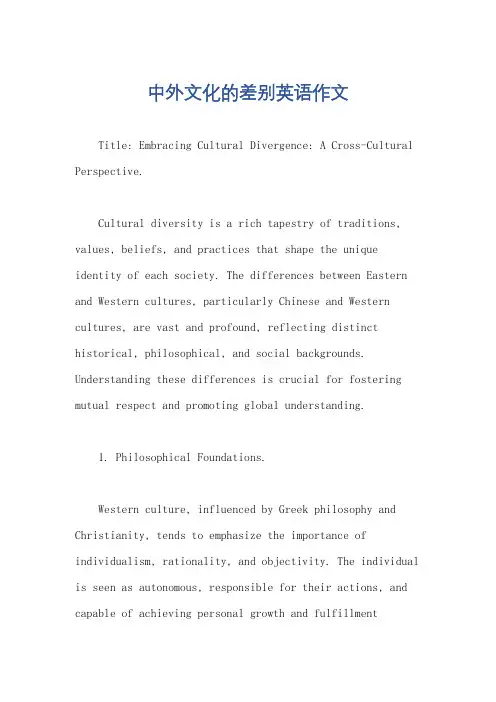
中外文化的差别英语作文Title: Embracing Cultural Divergence: A Cross-Cultural Perspective.Cultural diversity is a rich tapestry of traditions, values, beliefs, and practices that shape the unique identity of each society. The differences between Eastern and Western cultures, particularly Chinese and Western cultures, are vast and profound, reflecting distinct historical, philosophical, and social backgrounds. Understanding these differences is crucial for fostering mutual respect and promoting global understanding.1. Philosophical Foundations.Western culture, influenced by Greek philosophy and Christianity, tends to emphasize the importance of individualism, rationality, and objectivity. The individual is seen as autonomous, responsible for their actions, and capable of achieving personal growth and fulfillmentthrough reason and critical thinking. In contrast, Chinese culture, influenced by Confucianism, Taoism, and Buddhism, values collectivism, harmony, and subjectivity. The individual is seen as part of a larger social fabric, where group harmony and social order are paramount.2. Social Norms and Etiquette.Western society tends to be more formal and direct in communication, with a focus on efficiency and clarity. Individuals are encouraged to express their opinions freely and engage in debates. Conversely, Chinese culture values politeness, indirect communication, and respect for authority. Expressions of gratitude, apologies, and requests are often softened with polite formulas and indirect suggestions.3. Values and Beliefs.Western culture tends to prioritize individual freedom, competitiveness, and material success. The pursuit of happiness and fulfillment is seen as a personal journey,often achieved through professional success and material acquisitions. In contrast, Chinese culture values harmony, modesty, and community well-being. The individual's success is often measured by their contributions to the family and society, rather than personal achievements.4. Art and Aesthetics.Western art tends to emphasize realism, abstraction, and individual expression. Artists strive to capture the essence of their subjects through techniques like painting, sculpture, and photography. Chinese art, on the other hand, values calligraphy, painting, and ceramics as forms ofself-expression and meditation. Art is seen as a means of connecting with nature, achieving inner harmony, and communicating with the divine.5. Diet and Cuisine.Western cuisine is known for its diversity and experimentation, with a focus on individual flavors and nutritional value. Meals are often served as separatecourses, emphasizing the presentation and taste of each dish. Chinese cuisine, in contrast, emphasizes balance, variety, and taste combinations. Dishes are often prepared with a variety of ingredients, reflecting the harmonious blend of flavors and textures that contribute to the overall dining experience.In conclusion, the differences between Chinese and Western cultures are vast and profound, reflecting their unique historical, philosophical, and social backgrounds. Understanding these differences is crucial for fostering mutual respect and promoting global understanding. By embracing cultural divergence and celebrating our differences, we can create a more inclusive and harmonious world.。
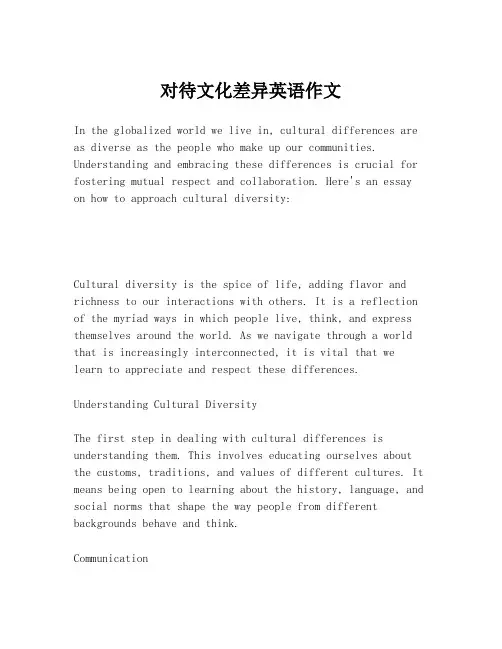
对待文化差异英语作文In the globalized world we live in, cultural differences are as diverse as the people who make up our communities. Understanding and embracing these differences is crucial for fostering mutual respect and collaboration. Here's an essay on how to approach cultural diversity:Cultural diversity is the spice of life, adding flavor and richness to our interactions with others. It is a reflection of the myriad ways in which people live, think, and express themselves around the world. As we navigate through a world that is increasingly interconnected, it is vital that we learn to appreciate and respect these differences.Understanding Cultural DiversityThe first step in dealing with cultural differences is understanding them. This involves educating ourselves about the customs, traditions, and values of different cultures. It means being open to learning about the history, language, and social norms that shape the way people from different backgrounds behave and think.CommunicationEffective communication is key when dealing with cultural differences. It is important to listen actively and empathetically, to understand the other person's perspective. Misunderstandings can often arise from differences in communication styles, so being patient and attentive can help to bridge these gaps.RespectRespecting cultural differences means acknowledging that all cultures have value and are equally important. It involves refraining from making judgments or assumptions based onone's own cultural background. Respect also means being willing to adapt and adjust one's behavior to accommodate the cultural norms of others.AppreciationAppreciating cultural diversity involves celebrating the unique contributions that different cultures make to our global community. This can be as simple as enjoying the food, music, or art of another culture, or as profound as learning from the wisdom and insights that different cultures offer.Overcoming StereotypesOne of the biggest challenges in dealing with cultural differences is overcoming stereotypes and prejudices. It is essential to challenge our own biases and to question the assumptions that we may hold about people from different cultures.ConclusionIn conclusion, embracing cultural differences is not just a matter of being polite or politically correct. It is a way of enriching our own lives and broadening our perspectives. By understanding, communicating, respecting, appreciating, and overcoming stereotypes, we can create a more harmonious and inclusive world. Let us all strive to be cultural ambassadors, promoting understanding and respect for the diverse tapestryof human culture.。
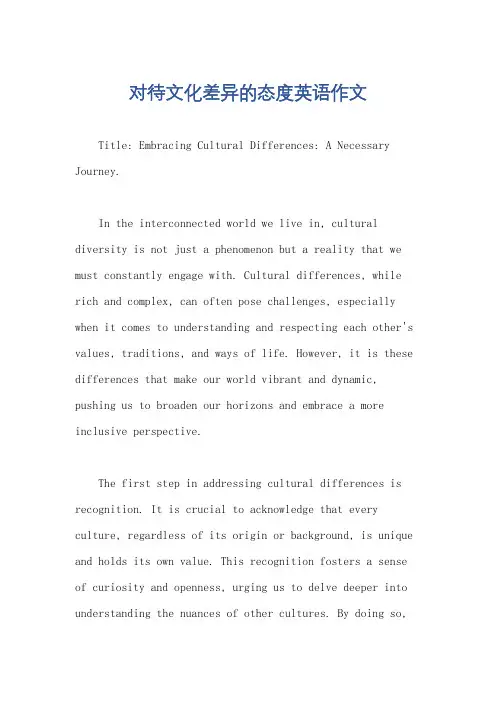
对待文化差异的态度英语作文Title: Embracing Cultural Differences: A Necessary Journey.In the interconnected world we live in, cultural diversity is not just a phenomenon but a reality that we must constantly engage with. Cultural differences, while rich and complex, can often pose challenges, especially when it comes to understanding and respecting each other's values, traditions, and ways of life. However, it is these differences that make our world vibrant and dynamic, pushing us to broaden our horizons and embrace a more inclusive perspective.The first step in addressing cultural differences is recognition. It is crucial to acknowledge that every culture, regardless of its origin or background, is unique and holds its own value. This recognition fosters a sense of curiosity and openness, urging us to delve deeper into understanding the nuances of other cultures. By doing so,we not only expand our knowledge but also enhance ourability to communicate and connect with people from different backgrounds.Furthermore, embracing cultural differences requires a willingness to adapt. In a globalized world, where people from diverse cultures interact frequently, it is inevitable that misunderstandings and conflicts will arise. However, rather than viewing these differences as obstacles, we should embrace them as opportunities for growth and learning. By adapting our communication style, behavior, and even our mindset, we can bridge the gaps and foster meaningful relationships across cultures.Additionally, respecting cultural differences is paramount. It is essential to appreciate the fact that each culture is shaped by its unique historical, social, and environmental context. Therefore, it is not surprising that different cultures may have differing values, beliefs, and norms. By respecting these differences, we show respect for the people who hold these values and, in turn, foster a more inclusive and harmonious society.Moreover, the celebration of cultural differences adds a rich layer of diversity and creativity to our world. The exchange of ideas, traditions, and practices across cultures not only enhances our understanding of each other but also contributes to the development of new ideas and perspectives. This cultural exchange is crucial for fostering innovation, creativity, and progress.However, embracing cultural differences is not always easy. It requires conscious effort, patience, and a willingness to step outside our comfort zones. It is a journey that involves constant learning, reflection, and adjustment. But the rewards of this journey are immense. By embracing cultural differences, we not only enhance our own growth and development but also contribute to building a more inclusive, understanding, and connected world.In conclusion, cultural differences are an integral part of our globalized world. By embracing these differences, we can expand our horizons, foster meaningful relationships, and contribute to the development of a moreharmonious and prosperous society. It is a journey that requires openness, understanding, and respect, but one that is rich in rewards and opportunities for growth. Let us embark on this journey together, embracing the beauty and richness of cultural diversity.。
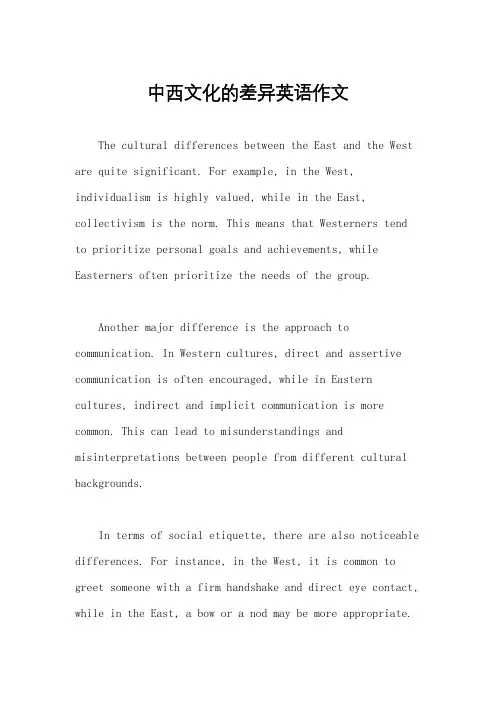
中西文化的差异英语作文The cultural differences between the East and the West are quite significant. For example, in the West, individualism is highly valued, while in the East, collectivism is the norm. This means that Westerners tend to prioritize personal goals and achievements, while Easterners often prioritize the needs of the group.Another major difference is the approach to communication. In Western cultures, direct and assertive communication is often encouraged, while in Eastern cultures, indirect and implicit communication is more common. This can lead to misunderstandings and misinterpretations between people from different cultural backgrounds.In terms of social etiquette, there are also noticeable differences. For instance, in the West, it is common to greet someone with a firm handshake and direct eye contact, while in the East, a bow or a nod may be more appropriate.Additionally, concepts of personal space and physical touch vary greatly between the two cultures.Cuisine is another area where the East and the West differ significantly. Western cuisine often emphasizes individual flavors and ingredients, while Eastern cuisine focuses on achieving a balance of flavors and textures. Additionally, the use of utensils and dining etiquette also vary between the two cultures.In conclusion, the differences between Eastern and Western cultures are vast and can impact various aspects of life including communication, social interactions, anddaily habits. It is important to recognize and understand these differences in order to foster better cross-cultural understanding and communication.。
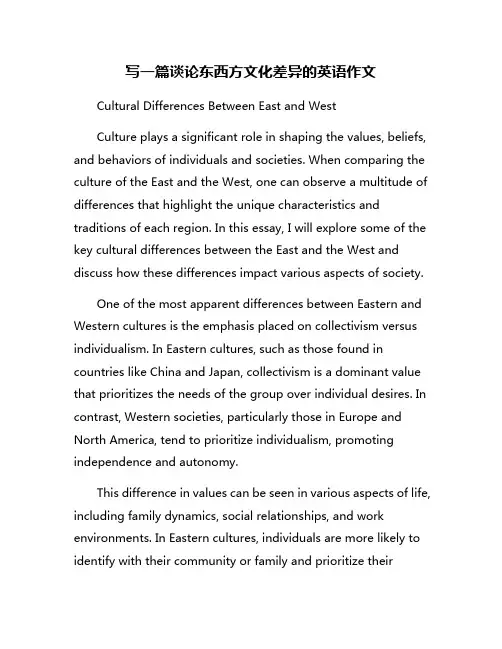
写一篇谈论东西方文化差异的英语作文Cultural Differences Between East and WestCulture plays a significant role in shaping the values, beliefs, and behaviors of individuals and societies. When comparing the culture of the East and the West, one can observe a multitude of differences that highlight the unique characteristics and traditions of each region. In this essay, I will explore some of the key cultural differences between the East and the West and discuss how these differences impact various aspects of society.One of the most apparent differences between Eastern and Western cultures is the emphasis placed on collectivism versus individualism. In Eastern cultures, such as those found in countries like China and Japan, collectivism is a dominant value that prioritizes the needs of the group over individual desires. In contrast, Western societies, particularly those in Europe and North America, tend to prioritize individualism, promoting independence and autonomy.This difference in values can be seen in various aspects of life, including family dynamics, social relationships, and work environments. In Eastern cultures, individuals are more likely to identify with their community or family and prioritize theirwell-being over personal gratification. On the other hand, Western societies tend to value personal achievement andself-expression, leading to more individualistic behaviors and attitudes.Another significant cultural difference between East and West is the approach to communication and conflict resolution. In Eastern cultures, communication tends to be more indirect and subtle, with an emphasis on maintaining harmony and avoiding confrontation. In contrast, Western cultures value direct communication and transparency, often leading to open and honest discussions about conflict and disagreement.These differences in communication styles can impact how individuals interact with one another and navigate social relationships. For example, in Eastern cultures, individuals may use nonverbal cues and gestures to convey their thoughts and feelings, whereas in Western cultures, individuals are more likely to express themselves verbally and directly.Furthermore, the concept of time is perceived differently in Eastern and Western cultures. In Western societies, time is often viewed as a commodity that should be spent efficiently, leading to a focus on deadlines and schedules. On the other hand, in many Eastern cultures, time is seen as a fluid and flexible concept,with an emphasis on relationships and experiences rather than strict adherence to a schedule.These cultural differences in attitudes towards time can impact how individuals prioritize their activities and manage their schedules. For example, individuals from Western cultures may expect punctuality and efficiency in their interactions, while individuals from Eastern cultures may prioritize building relationships and investing time in social connections.In conclusion, the cultural differences between the East and the West highlight the diversity and richness of human societies. By understanding and appreciating these differences, we can gain a deeper insight into the values, beliefs, and behaviors of individuals from different cultural backgrounds. Ultimately, recognizing and respecting cultural diversity is essential for promoting understanding and cooperation in an increasingly interconnected world.。
中西恭维差异英语作文Title: Cultural Differences in Compliments betweenChina and the West。
In cross-cultural communication, understanding the nuances of compliments is essential for effective interaction. Compliments serve as social lubricants, establishing rapport and conveying positive regard. However, the way compliments are given and received varies significantly between China and Western cultures. Let's delve into the differences in complimenting etiquette between these two cultural spheres.Firstly, in Chinese culture, compliments are often more indirect and modest compared to Western cultures. It's common for individuals to downplay their accomplishments or attributes when receiving compliments. For instance, if someone praises a Chinese person's appearance, they might respond with a modest "It's nothing special" or "You're too kind." This modesty stems from Confucian values emphasizinghumility and avoiding arrogance.Conversely, in Western cultures, directness andsincerity are valued in compliments. When someone receivesa compliment, they are more likely to accept it graciously without downplaying their achievements or attributes. For example, if praised for their outfit, a Westerner might respond with a simple "Thank you, I'm glad you like it," without diminishing the compliment.Moreover, the topics of compliments differ betweenChina and the West. In China, compliments often focus on qualities related to hard work, diligence, and perseverance. Academic or professional achievements are highly regarded, and compliments may center around someone's dedication or improvement in these areas. For instance, praising someone for their persistence in overcoming challenges or for their continuous efforts to excel in their studies or career is common.In contrast, in Western cultures, compliments extend beyond just achievements and often encompass individualismand personal expression. Compliments may revolve around creativity, uniqueness, or charisma. For example, someone might compliment another person's sense of humor,creativity in problem-solving, or their ability to think outside the box.Furthermore, the frequency of giving compliments varies between the two cultures. In China, compliments are often sparingly given, especially in formal or professional settings. Excessive praise may be perceived as insincere or even as an attempt to curry favor. Instead, compliments are usually reserved for genuinely remarkable accomplishments or behaviors.On the other hand, in Western cultures, compliments are more freely given as a way to express appreciation andbuild rapport. It's common to offer compliments in both personal and professional settings, whether it's admiring someone's work performance, acknowledging their contributions in a meeting, or simply appreciating their kindness.Additionally, cultural norms dictate the manner in which compliments are expressed. In China, compliments may be conveyed indirectly through gestures, such as offering gifts or gestures of respect. Non-verbal cues, such as a smile or nod of approval, can also serve as subtle compliments.In Western cultures, verbal communication plays a more prominent role in complimenting. Compliments are often articulated explicitly, with individuals expressing admiration or praise through words. Whether it's a simple "You did a great job" or a more elaborate acknowledgment of someone's talents, verbal compliments are valued for their clarity and sincerity.In conclusion, while compliments serve similar social functions across cultures, the manner in which they are given and received can vary significantly between China and the West. Understanding these cultural differences is crucial for effective cross-cultural communication and building meaningful relationships. By respecting eachother's complimenting etiquette, individuals can navigate cultural differences with grace and appreciation.。
文化差异英语演讲稿Enrich Our Culture, Diverse Our CultureSpeaking of the future of our culture, I strongly believe that the culture will be more and more diverse.Firstly, you must be astonished when a native Australian ties to welcome you by touching your nose; you may not believe that even men can wear skirts, but that’s what Scottish men do; you can hardly picture what a woman or girl would like be with a plate-like mouth in an African tribe. And it is cultural diversity that colors our world.Besides, it helps preserve our own cultures.A few years ago, the balance of our own culture and others was broken by the flood of TV plays and cultures from Japan and South Korea. What’s worse, when did we begin to celebrate Christmas or Valentines’ Day and not be able to tell the date of Tomb-sweeping Day? However nowadays, with the defense of the importance of our own culture and the heat of Chinese traditional culture, like Confucianism and Taoism, our awareness of national confidence, patriotism and solidarity has increased greatly.Lastly, cultural diversity does not mean to resist or to accept all the other cultures. It’s based on one’s own culture. (Imagine that all the other family members are enjoying theirdumplings with their chopsticks while you taking out a pair of knife and fork and cutting the dumplings into pieces so that you are able to eat. I’m absolutely sure you will appear in the front page of Humor the next day. Do as Romans do).And I think we had enough lessons learned from the Opium War of 1840 due to which numerous of our fellow countrymen died while the British made a good fortune. Just like the Chinese sayings of “two heads are better than one” and “abolish its defects, absorb its merits.” say, only by absorbing good ideas from other cultures and applying them to ours can we better develop our nation and better serve our people.To sum up, culture diversity makes our world more colorful, fulfills our pursuit for knowledge, and unites its own country. So let’s learn to respect different cultures and enrich our own ones.文化差异英语演讲稿 [篇2]答cultural difference between west and easteverything is relative,cultural difference being noexception.culture,as the total pattern of human behavior and its products,oversteps geographical limits and historical conditions in many ways,and it is characterized by its strong penetrativeness and fusibility.the advancement of the globalized economy and the rapidity and ease of modern communication,transportation,and mass media have resulted in an ever increasing exchange between cultures,unprecedented inscale,scope,and #url#nsequently,an increase in universality and a reduction in difference between cultures is an inevitable trend.it is no surprise to see phenomena characteristic of one culture existing in another.as a result,some people even fear that the world will become a dull place when all the different nationalities behave exactly alike.nevertheless,the “cultural sediment” formed through long-range accumulation is not to be easily removed,and the cultural tradition handed down from generation to generation shows great consistency and continuity.the cultures of different regions and nations still havetheir own distinctive peculiarities,and therefore significance still needs to be attached to the study of the individualities of different cultures against the background of their universality.。
西方文化差异的英文作文英文:As a Chinese who has lived in the United States for several years, I have experienced and observed manycultural differences between the East and the West. These differences are not only reflected in daily life, but alsoin social norms, communication styles, and even work ethics.One of the most noticeable differences is the conceptof personal space. In Western culture, people tend to value their personal space and may feel uncomfortable if someone invades it. For example, in the US, it is common to standat least an arm's length away from someone when having a conversation. On the other hand, in Chinese culture, people are more accustomed to standing closer to each other, andit is not uncommon for friends to hold hands or link arms while walking.Another aspect of Western culture that differs fromChinese culture is the directness in communication. In the US, people tend to be more straightforward and may express their opinions or feedback openly. For example, if a colleague disagrees with your idea in a meeting, they may directly say so without beating around the bush. In contrast, in Chinese culture, people often use indirect communication to convey their thoughts and may avoid confrontation or disagreement in public settings.Furthermore, work ethics in the West also differ from those in China. In the US, punctuality is highly valued, and being on time for appointments or meetings is considered a sign of respect. Additionally, there is a strong emphasis on individualism and taking initiative in the workplace. On the other hand, in China, relationships and hierarchy play a significant role in work dynamics, and there may be more emphasis on group harmony and consensus-building.These cultural differences have influenced my dailylife in the US in various ways. For instance, when I first moved to the US, I found it challenging to adapt to theconcept of personal space, as I was used to standing closer to others while conversing. I also had to adjust my communication style to be more direct and assertive in order to effectively express my thoughts and ideas in a Western work environment.中文:作为一个在美国生活了几年的中国人,我经历和观察到了东西方文化之间的许多差异。
关于世界各地文化差异的作文英语The world is a vast and diverse place filled with a myriad of cultures and traditions that make it a rich tapestry of human experience. From the ancient civilizations of the East to the modern metropolises of the West, each region of the globe boasts its own unique cultural heritage that has been shaped by centuries of history, geography, and social evolution. Understanding and appreciating these cultural differences is not only fascinating but also crucial in fostering greater global understanding and harmony.One of the most striking cultural differences can be seen in the varying approaches to family and social structures across the world. In many Eastern cultures, such as those found in Asia, the family unit is the cornerstone of society, with strong emphasis placed on filial piety, respect for elders, and the collective good of the group over individual desires. This is in stark contrast to the more individualistic nature of Western societies, where personal autonomy and self-expression are often prioritized.Similarly, the role of religion and spirituality in shaping culturalnorms and practices varies greatly across the globe. In the Middle East, for example, Islamic traditions and beliefs permeate every aspect of daily life, from dietary restrictions to modes of dress and social interactions. Conversely, in many Western nations, the separation of church and state has led to a more secularized public sphere, with religion playing a less overt role in the lives of citizens.Another significant cultural difference can be observed in the diverse approaches to time and punctuality. In some cultures, such as those found in Latin America, a more relaxed and fluid concept of time is embraced, with schedules and deadlines often treated as flexible guidelines rather than strict obligations. In contrast, Northern European and North American societies tend to place a higher value on punctuality and efficiency, with strict adherence to schedules and deadlines seen as a mark of professionalism and respect.The ways in which different cultures engage with the natural world and their physical environments also vary greatly. Indigenous communities in the Amazon rainforest, for instance, have developed intricate knowledge and sustainable practices for living in harmony with their surrounding ecosystems, while urban populations in the developed world often find themselves increasingly disconnected from the natural world.Culinary traditions are another fascinating aspect of cultural diversity,with each region of the world boasting its own unique flavors, ingredients, and cooking methods. From the spice-laden curries of India to the delicate sushi of Japan, the world's diverse culinary landscapes reflect the rich tapestry of human experience and the ingenuity of the human spirit.Beyond these more tangible aspects of culture, there are also profound differences in the ways in which various societies approach concepts of beauty, art, and self-expression. What is considered aesthetically pleasing or artistically significant in one culture may be viewed quite differently in another, reflecting the deeply subjective and context-dependent nature of these human endeavors.Ultimately, the cultural differences that exist across the world are a testament to the incredible diversity and complexity of the human experience. While these differences can sometimes lead to misunderstandings or even conflicts, they also offer an opportunity for mutual learning, growth, and appreciation. By embracing and celebrating the unique cultural traditions of our global community, we can foster a deeper sense of interconnectedness and shared humanity, paving the way for a more just, equitable, and peaceful world.。
文化差异英语作文初一Title: Embracing Cultural DifferencesIn the vast and diverse world we live in, cultural differences are inevitable. They shape our identities, influence our ways of thinking, and determine our behavior patterns. As a freshman in junior high school, I have begun to appreciate the beauty of these differences and understand their importance in creating a rich and vibrant global society.Firstly, cultural differences are a reflection of the unique histories, traditions, and values of different communities. For instance, in some cultures, it is customary to greet elders with a bow, while in others, a handshake or a hug is preferred. Similarly, some cultures emphasize collectivism and community harmony, while others value individualism and competitiveness. These differences are not just superficial; they reflect deep-seated beliefs and values that have been passed down through generations. Secondly, cultural differences contribute to the diversity and creativity of our world. When people fromdifferent cultures come together, they bring their unique perspectives, ideas, and ways of doing things. Thisdiversity enriches our understanding of the world and spurs innovation and creativity. For example, in the field of art, the fusion of different cultural elements often leads tothe creation of new and exciting forms of expression.However, cultural differences can also lead to misunderstandings and conflicts. Sometimes, our owncultural norms and values can act as blinders, preventingus from seeing the world through the eyes of others. This can lead to misunderstandings and even conflicts in interpersonal relationships. To overcome this, it is important to cultivate a mindset of openness and tolerance. We should be willing to listen to others, understand their perspectives, and respect their differences.In school, we are often exposed to classmates from diverse cultural backgrounds. This presents a unique opportunity for us to learn about and appreciate different cultures. We can participate in cultural exchangeactivities, such as festivals or workshops, to experience other cultures firsthand. Additionally, we can read booksand watch movies that depict different cultures, which can help us broaden our horizons and develop a more inclusive mindset.Moreover, the internet has made it easier for us to connect with people from around the world. Through social media and online forums, we can engage in conversations with people from different cultures, share our experiences, and learn from theirs. This not only enhances our understanding of other cultures but also helps us develop a global perspective.In conclusion, cultural differences are an integral part of our world and should be celebrated. They enrich our lives, contribute to the diversity and creativity of our society, and provide us with valuable opportunities for learning and growth. As students, we should be open to exploring and understanding different cultures, and strive to cultivate a mindset of tolerance and respect. By doing so, we can build bridges of understanding and friendship across cultural divides and create a more harmonious and inclusive world.。
Derek Sivers: Weird, or just different?
/talks/derek_sivers_weird_or_just_different.html
About this talk
"There's a flip side to everything," the saying goes, and in 2 minutes, Derek Sivers shows this is true in a few ways you might not expect.
About Derek Sivers
Through his new project, MuckWork, Derek Sivers wants to lessen the burdens (and boredom) of creative people.
Transcript
So, imagine you're standing on a street anywhere in America and a Japanese man comes up to you and says,
"Excuse me, what is the name of this block?"
And you say, "I'm sorry. Well, this is Oak Street, that's Elm Street. This is 26th, that's 27th."
He says, "Well, okay. What is the name of that block?"
Y ou say, "Well, blocks don't have names. Streets have names; blocks are just the unnamed spaces in between streets."
He leaves, a little confused and disappointed.
So, now imagine you're standing on a street, anywhere in Japan, you turn to a person next to you and say,
"Excuse me, what is the name of this street?"
They say, "Oh, well that's block 17 and this is block 16."
And you say, "Okay, but what is the name of this street?"
And they say, "Well, streets don't have names. Blocks have names. Just look at Google Maps here. There is block 14, 15, 16, 17, 18, 19. All of these blocks have names. The streets are just the unnamed spaces in between the blocks.
And you say then, "Okay, then how do you know your home address?"
He said, "Well, easy, this is District Eight. There is block 17, house number One."
Y ou say, "Okay. But walking around the neighborhood, I noticed that the house numbers don't go in order."
He says, "Of course they do. They go in the order in which they were built. The first house ever built on a block is house number one. The second house ever built is house number two. Third is house number three. It's easy. It's obvious."
So, I love that sometimes we need to go to the opposite side of the world to realize assumptions we didn't even know we had, and realize that the opposite of them may also be true.
So, for example, there are doctors in China who believe that it's their job to keep you healthy. So, any month you are healthy you pay them, and when you're sick you don't have to pay them because they failed at their job. They get rich when you're healthy, not sick. (Applause)
In most music we think of the "one" as the downbeat, the beginning of the musical phrase. One, two three four. But in West African music the "one" is thought of as the end of the phrase, like the period at the end of a sentence. So, you can hear it not just in the phrasing, but the way they count off their music. Two, three, four, one.
And this map is also accurate. (Laughter)
There is a saying that whatever true thing you can say about India, the opposite is also true. So, let's never forget, whether at TED, or anywhere else, that whatever brilliant ideas you have or hear, that the opposite may also be true. Domo arigato gozaimashita.。